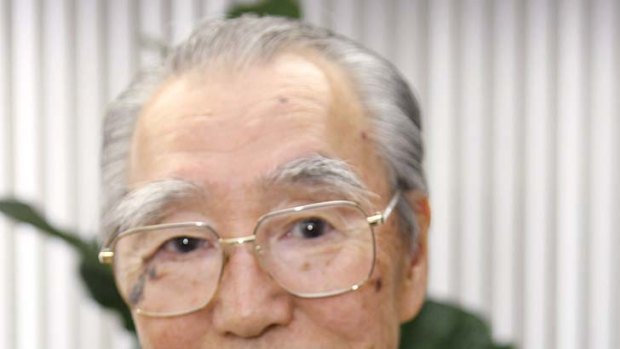This was published 13 years ago
He made impossible possible
Nobutoshi Kihara, 1926-2011
Nobutoshi Kihara was the engineer known as the ''Wizard of Sony'' for his ingenuity in developing products - Japan's first tape recorder and transistor radio and the Betamax videocassette recorder - that helped propel the company's rise from the ashes of war to global electronics giant.
Kihara, whose innovations helped win more than 700 patents, led in developing the company's first success, a magnetic tape recorder and its magnetic tape. The transistor radio and television, one of the world's first videotape recorders the Betamax, eight-millimetre video movies, the digital still camera known as Mavica and a catalogue of smaller, lighter variations of these followed.

Radio waves ... Nobutoshi Kihara with Sony's Movica camera.Credit: AFP
Though Kihara was widely known as ''Mr Walkman'', another engineer created the world's first commercial personal stereo system. But Kihara's earlier innovations provided the backbone for the Walkman. Akio Morita, one of Sony's two founders, had asked Kihara, then a top engineering executive, to find a way for him to listen to operas on long-haul business flights.
It was Kihara's relationship with Sony's other founder, Masaru Ibuka, that rained magic. Projects usually began with a rambling, almost telepathic conversation in which Ibuka was careful not to offend Kihara by issuing a direct order. Often, as soon as the next day, Kihara would delightedly show Ibuka a prototype of the concept they had discussed.
''I loved making him happy,'' Kihara said; Ibuka referred to Kihara as ''a godlike person'' in one of his books.
Nobutoshi Kihara was born in Tokyo on October 14, 1926. His family had a background in engineering and as a boy he enjoyed dissecting the motor of his model locomotive. To pay uni fees, he fixed discarded radios.
In 1947, as he was preparing to graduate from Waseda University in Tokyo, he responded to a job ad on a bulletin board placed by the Tokyo Telecommunications Engineering Company, which would become Sony.
Kihara's exuberance about electronics - and experience with radios - wiped concerns that his background was in mechanical, not electrical, engineering. His first major development was a tape recorder: he heated ground iron in a frypan to collect the ferric oxide needed for magnetic tape.
A shortage of court stenographers created an immediate market for the recorders. He kept developing smaller models.
Ibuka came up with the idea of using transistors in radios. Kihara produced one, and in August 1955 the first transistor radio in Japan went on sale. An American company called Regency, using Texas Instruments transistors, beat Sony to the market by a month.
Sony's transistor radio was immediately profitable. Kihara then found ways to use transistors in TVs and tape recorders, making miniaturisation and lower power consumption easier. He led Sony's advance into videotape and videocassette recorders. Betamax lost out to the VHS of Konosuke Matsushita (Panasonic), which was cheaper and could hold more program.
Kihara, who is survived by his wife and three children, always insisted that Betamax's technology was superior. ''My blood boils,'' he said of VHS's victory over Betamax. He claimed he could close his eyes and imagine new products.
''Anyone can find out the commonsense things and my role is not to teach common sense,'' he told the Centre for the History of Electrical Engineering in 1994. ''My message has always been to break through what is common sense and common knowledge and make the impossible possible.''
The New York Times